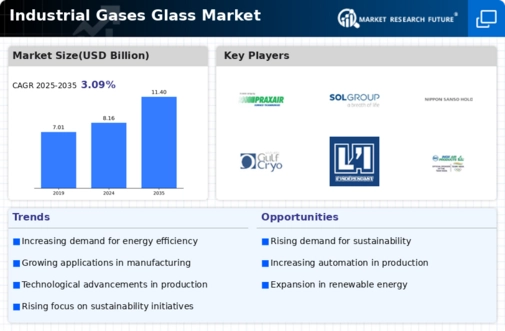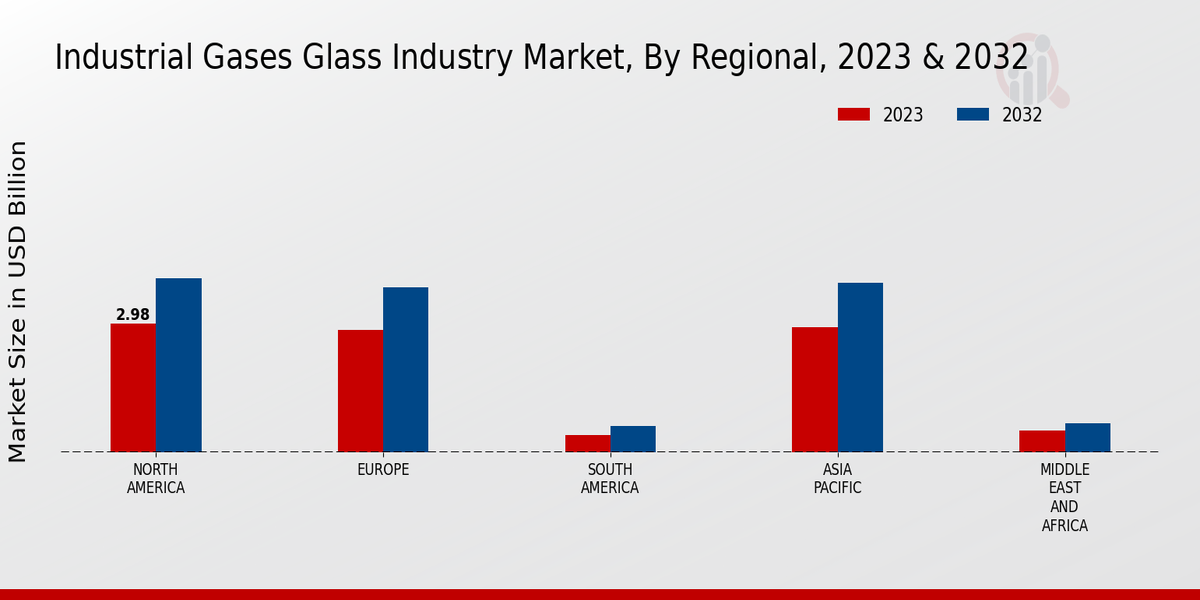Emerging Markets and Urbanization
Emerging markets, particularly in Asia and Africa, are witnessing rapid urbanization, which significantly impacts the Global Industrial Gases Glass Market Industry. As urban populations grow, there is an escalating demand for residential and commercial buildings, leading to increased glass consumption. This urbanization trend is accompanied by a shift towards modern construction practices that favor glass as a primary material. The influx of investments in infrastructure development further supports this growth. As these regions continue to develop, the market is poised for expansion, with projections indicating a growth trajectory that aligns with the overall market trends.
Growing Demand for Glass Products
The Global Industrial Gases Glass Market Industry experiences a notable increase in demand for glass products across various sectors, including construction and automotive. This trend is driven by the rising need for energy-efficient and sustainable building materials. For instance, the construction industry is projected to utilize more glass for facades and windows, enhancing thermal performance. As a result, the market is anticipated to reach 8.16 USD Billion in 2024, reflecting a robust growth trajectory. The increasing adoption of glass in innovative applications, such as smart windows, further propels this demand, indicating a shift towards more advanced glass technologies.
Expansion of the Automotive Sector
The automotive sector plays a crucial role in driving the Global Industrial Gases Glass Market Industry. With the increasing production of vehicles, there is a growing demand for specialized glass components, such as windshields and windows. The trend towards lightweight and fuel-efficient vehicles further necessitates the use of advanced glass materials. This expansion is supported by the rising consumer preference for safety and aesthetics in vehicle design. Consequently, the automotive industry's growth is expected to contribute significantly to the market's overall expansion, aligning with the anticipated increase in market value to 8.16 USD Billion in 2024.
Regulatory Support for Sustainable Practices
The Global Industrial Gases Glass Market Industry benefits from increasing regulatory support aimed at promoting sustainable practices. Governments worldwide are implementing stringent environmental regulations that encourage the use of eco-friendly materials and processes. For example, initiatives aimed at reducing carbon emissions in glass manufacturing are gaining traction, leading to a shift towards cleaner industrial gases. This regulatory landscape not only fosters innovation but also drives investment in sustainable technologies. As a result, the market is expected to expand, with projections indicating a growth to 11.4 USD Billion by 2035, reflecting the industry's adaptation to evolving environmental standards.
Technological Advancements in Gas Production
Technological innovations in the production of industrial gases significantly influence the Global Industrial Gases Glass Market Industry. Enhanced production methods, such as cryogenic distillation and membrane separation, improve efficiency and reduce costs. These advancements enable manufacturers to supply high-purity gases essential for glass production, thereby meeting the stringent quality requirements of the industry. Furthermore, the integration of automation and digital technologies streamlines operations, leading to increased productivity. This evolution in gas production technology not only supports the growth of the market but also aligns with the projected CAGR of 3.1% from 2025 to 2035, indicating a sustained upward trend.



 Source: Primary Research, Secondary Research, MRFR Database and Analyst Review
Source: Primary Research, Secondary Research, MRFR Database and Analyst Review















Leave a Comment